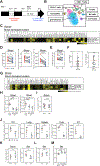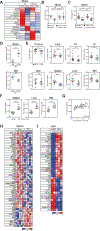Dietary Intake Regulates the Circulating Inflammatory Monocyte Pool
- PMID: 31442403
- PMCID: PMC7357241
- DOI: 10.1016/j.cell.2019.07.050
Dietary Intake Regulates the Circulating Inflammatory Monocyte Pool
Abstract
Caloric restriction is known to improve inflammatory and autoimmune diseases. However, the mechanisms by which reduced caloric intake modulates inflammation are poorly understood. Here we show that short-term fasting reduced monocyte metabolic and inflammatory activity and drastically reduced the number of circulating monocytes. Regulation of peripheral monocyte numbers was dependent on dietary glucose and protein levels. Specifically, we found that activation of the low-energy sensor 5'-AMP-activated protein kinase (AMPK) in hepatocytes and suppression of systemic CCL2 production by peroxisome proliferator-activator receptor alpha (PPARα) reduced monocyte mobilization from the bone marrow. Importantly, we show that fasting improves chronic inflammatory diseases without compromising monocyte emergency mobilization during acute infectious inflammation and tissue repair. These results reveal that caloric intake and liver energy sensors dictate the blood and tissue immune tone and link dietary habits to inflammatory disease outcome.
Keywords: AMPK; CCL2; Caloric restriction; PPARα; fasting; inflammation; inflammatory disease; liver; metabolism; monocyte.
Copyright © 2019. Published by Elsevier Inc.
Conflict of interest statement
DECLARATION OF INTERESTS
The authors declare no competing interests.
Figures






Comment in
-
When Fasting Gets Tough, the Tough Immune Cells Get Going-or Die.Cell. 2019 Aug 22;178(5):1038-1040. doi: 10.1016/j.cell.2019.07.052. Cell. 2019. PMID: 31442398 Free PMC article.
-
Fast tracking immunity.Nat Rev Immunol. 2019 Oct;19(10):598. doi: 10.1038/s41577-019-0219-3. Nat Rev Immunol. 2019. PMID: 31477874 No abstract available.
-
Bone Marrow: An Immunometabolic Refuge during Energy Depletion.Cell Metab. 2019 Oct 1;30(4):621-623. doi: 10.1016/j.cmet.2019.08.022. Cell Metab. 2019. PMID: 31577929
References
-
- Ajami B, Bennett JL, Krieger C, McNagny KM, and Rossi FM (2011). Infiltrating monocytes trigger EAE progression, but do not contribute to the resident microglia pool. Nat Neurosci 14, 1142–1149. - PubMed
-
- Aksungar FB, Topkaya AE, and Akyildiz M (2007). Interleukin-6, C-reactive protein and biochemical parameters during prolonged intermittent fasting. Ann Nutr Metab 51, 88–95. - PubMed
-
- Boniakowski AE, Kimball AS, Joshi A, Schaller M, Davis FM, denDekker A, Obi AT, Moore BB, Kunkel SL, and Gallagher KA (2018). Murine macrophage chemokine receptor CCR2 plays a crucial role in macrophage recruitment and regulated inflammation in wound healing. European journal of immunology 48, 1445–1455. - PMC - PubMed
-
- Brocker CN, Yue J, Kim D, Qu A, Bonzo JA, and Gonzalez FJ (2017). Hepatocyte-specific PPARA expression exclusively promotes agonist-induced cell proliferation without influence from nonparenchymal cells. American journal of physiology Gastrointestinal and liver physiology 312, G283–G299. - PMC - PubMed
Publication types
MeSH terms
Substances
Grants and funding
LinkOut - more resources
Full Text Sources
Other Literature Sources
Medical
Molecular Biology Databases

